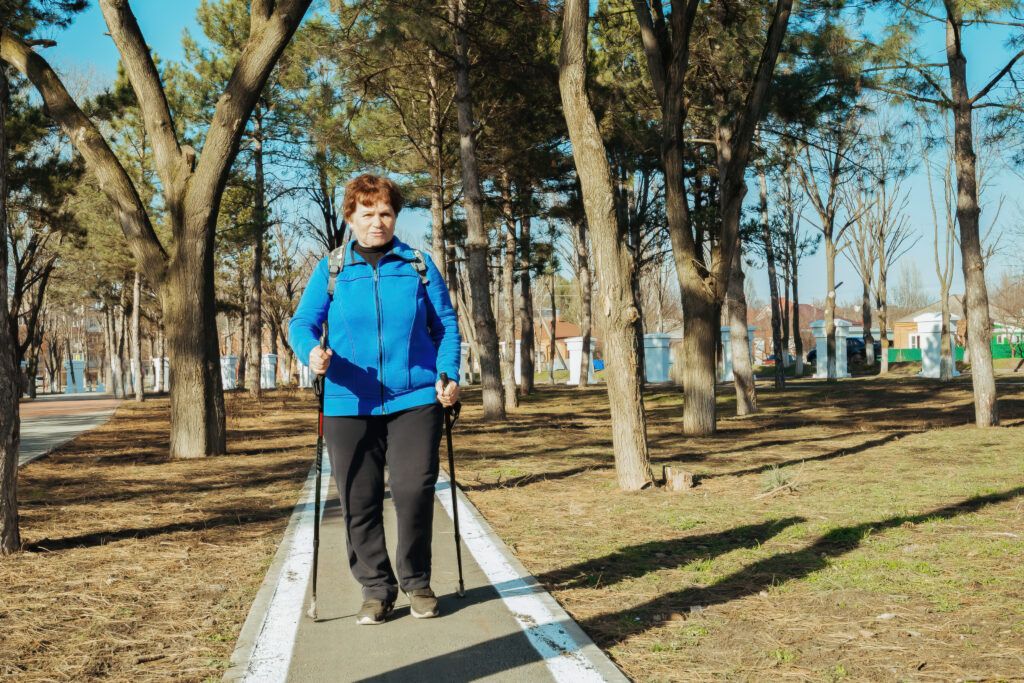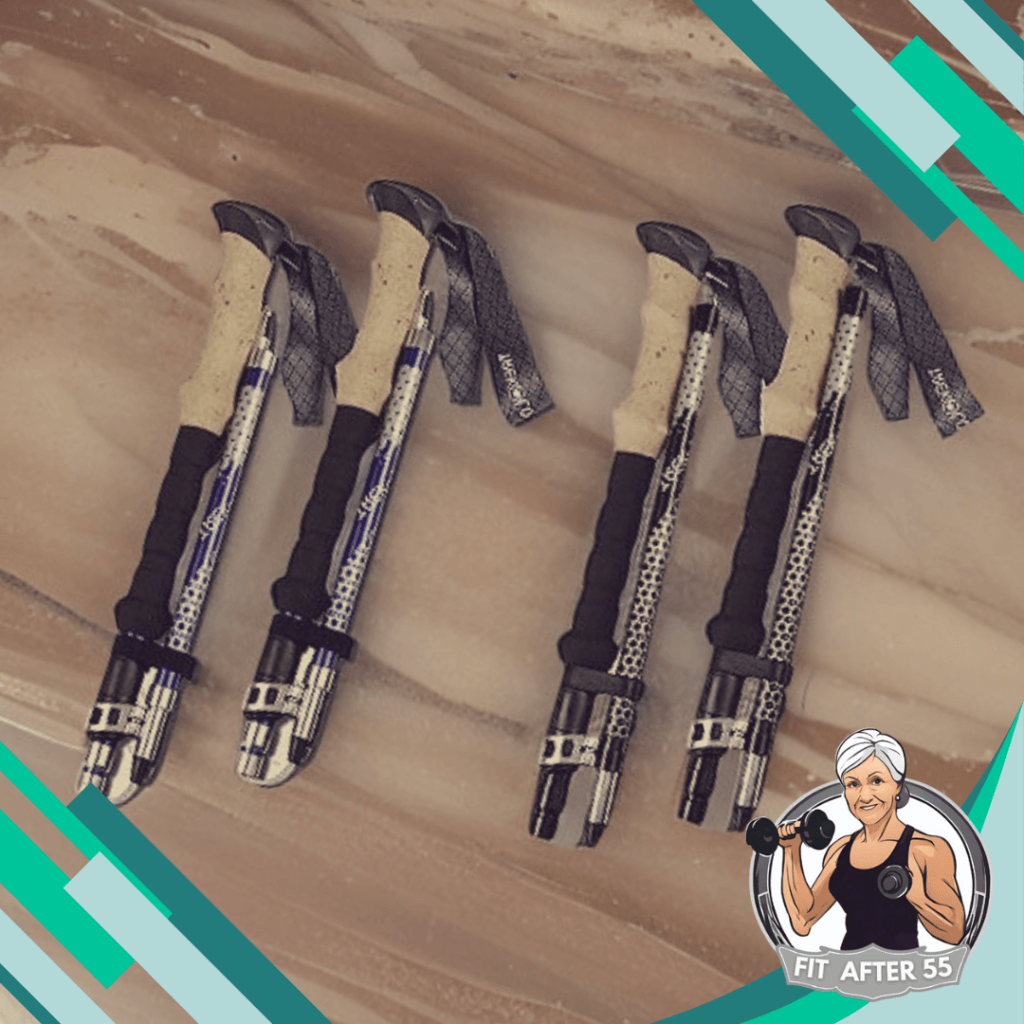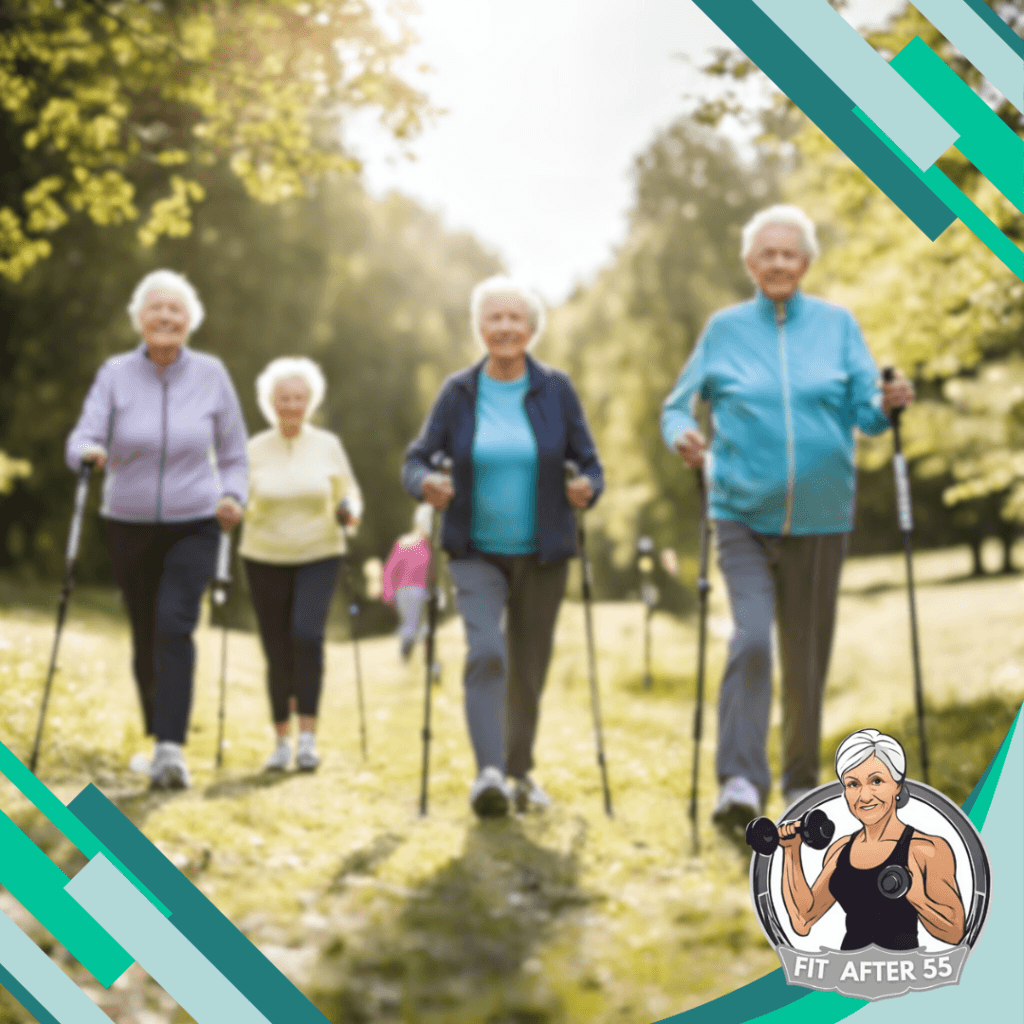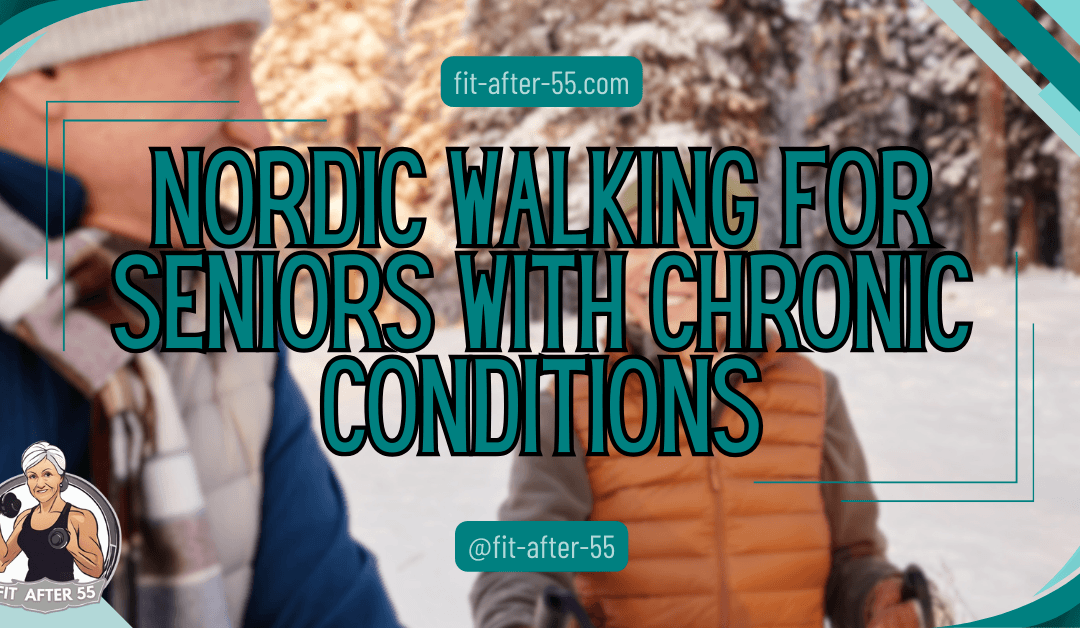Chronic conditions can cast a long shadow over one’s life, especially as we age. Yet, despite their weight, they need not define our journey or diminish our potential for vitality. In fact, for seniors facing the complexities of health challenges, there’s an invitation to reclaim power, to stride boldly into a realm of practical fitness.
Nordic Walking emerges as a beacon of possibility—a gentle yet potent exercise regimen that speaks to the heart of resilience and adaptability. In this article, we delve into the world of Nordic Walking, exploring its tailored approach for seniors managing chronic conditions. Here, we’ll uncover the transformative power of this full-body exercise, offering insights, techniques, and encouragement for anyone seeking to embrace wellness with every step.
Nordic Walking for Seniors with Chronic Conditions: Adapting Exercises for Health & Mobility
Nordic Walking is a full-body exercise that involves walking with specialized poles. It provides a host of benefits, especially for seniors managing chronic conditions. It’s a low-impact activity that can help improve cardiovascular health, strengthen muscles, and enhance balance.

Unlike traditional walking, the involvement of poles engages the upper body. This turns a simple walk into a robust workout that can be easily modified to suit individual health needs and fitness levels.
For seniors with chronic conditions such as arthritis, cardiovascular disease, or diabetes, tailoring a Nordic Walking routine is key to ensure both safety and effectiveness. The right approach to this form of exercise can help manage symptoms and improve overall quality of life without exacerbating existing health issues.
It’s important to consider the type of equipment used, the intensity and duration of walking sessions, and any necessary precautions. Professional guidance and understanding proper techniques can also play a significant role in maximizing the benefits and preventing injury.
Key Takeaways
- Nordic Walking is effective for improving overall health and is customizable for individuals with chronic conditions.
- Proper technique and equipment enhance the safety and benefits of the exercise.
- Professional guidance is recommended to tailor routines and set achievable health goals.
Understanding Nordic Walking

Nordic Walking is an exercise that enhances your physical wellbeing, particularly beneficial for those managing chronic conditions. It involves the use of specially designed poles to engage more muscle groups during walking.
Benefits for Seniors with Chronic Conditions
Nordic Walking presents several advantages for seniors, especially those living with chronic health issues. By using walking poles, you distribute your body weight and take pressure off your legs and back, which can be especially helpful if you have joint pain or are recovering from injury.
Studies, including those from the Cleveland Clinic, suggest that Nordic Walking can tap into more than 90% of the body’s muscles. This offers a comprehensive workout that is low impact yet effective.
The practice has also been linked to reductions in fat mass, and improvements in cardiovascular health, which are essential for managing conditions such as heart disease.
For seniors with chronic pain, combining Nordic Walking with strength and mobility training has been shown to reduce neck and lower back pain, while also enhancing overall quality of life.
History and Origin of Nordic Walking
Nordic Walking originated from Finland as a summer training exercise for cross-country skiers. It gained popularity in the 1990s as a fitness activity.
The technique is similar to the movements involved in cross-country skiing, where both the upper and lower parts of the body are engaged in a harmonious way. The distinct poles used in Nordic Walking were developed to maximize the benefits of this exercise for everyday use.
Nordic Walking sticks aid in propelling the walker forward, leading to a more intense workout compared to regular walking.
Equipment and Gear

When embarking on Nordic walking, particularly if you have chronic conditions, investing in the right equipment is crucial for both your comfort and safety.
Selecting the Right Walking Poles
Nordic walking poles are fundamental to the practice as they help distribute your body weight and reduce the load on your joints.
Look for poles that have adjustable lengths to match your height for proper ergonomics. Features such as shock absorption and durable, replaceable tips will enhance your walking experience. For example, lightweight aluminum or carbon poles offer durability and ease of use.
Appropriate Footwear and Clothing
Footwear: Always choose walking shoes with good support and non-slip soles to prevent falls. The best Nordic walking shoes will also have flexible soles to facilitate the natural heel-to-toe movement.
Clothing: Opt for moisture-wicking fabrics and layers that you can add or remove according to the weather. High-visibility or reflective garments are recommended if you’re walking in low-light conditions, ensuring you remain visible to others.
Getting Started with Nordic Walking
When beginning with Nordic walking, it’s essential to focus on mastering the basic techniques and proper posture, as well as incorporating warm-up routines to prepare your body for the activity.
Basic Techniques and Posture
To get the most out of Nordic walking, plant your poles at an angle behind you and push off with each step. Keep your arms straight as you swing the poles and ensure they alternate with your leg movements.
For correct posture, stand tall, relax your shoulders, and look ahead. This strength-building exercise engages over 90% of your body’s muscles, so proper form is key to avoid strain and maximize benefits.
Warm-Up Routines
Begin every Nordic walking session with a 5- to 10-minute warm-up to gently prepare your muscles and joints. A warm-up could include:
- Shoulder rolls to loosen the upper body
- Leg swings to warm up your hips and legs
- Walking in place to increase your heart rate
Adopting these routines reduces the chance of injury and helps to improve overall fitness, especially for seniors with chronic conditions looking to enhance their exercise regimen.
Tailoring Routines for Chronic Conditions
Customizing Nordic walking exercises for seniors with chronic conditions can help maximize the benefits while minimizing risk. It’s crucial to adapt the intensity, duration, and frequency of the routines to fit individual health profiles.
Cardiovascular Health
If you live with cardiovascular conditions, a low-to-moderate intensity routine with gradual progressions is beneficial.
Begin with shorter durations, ensuring to monitor heart rate and perceived exertion to stay within a safe range.
Nordic walking can enhance circulation and improve heart health, but should always align with the guidelines provided by your healthcare professional.
Joint and Musculoskeletal Disorders
For those with joint or musculoskeletal disorders, the focus should be on reducing joint stress.
Use Nordic walking poles to distribute weight more evenly and opt for soft, flat surfaces to minimize impact. Start with shorter strides and increase the frequency of walks before duration, paying close attention to any discomfort.
Diabetes Management
Incorporate Nordic walking into your routine to aid in blood sugar control.
Consistent, moderate-paced walking can improve insulin sensitivity, but it’s important to track blood sugar levels before and after physical activity.
Engage in shorter sessions that can be evenly distributed throughout the week to maintain a balanced exercise regimen.
Safety and Injury Prevention
When engaging in Nordic walking, you must prioritize safety and tailor your routine to prevent injuries. This includes careful monitoring of workout intensity and being proactive about fall prevention.
Monitoring Intensity and Heart Rate
To ensure a safe level of exercise, track your heart rate and keep it within a safe range suited to your health status.
This can often be between 50% to 70% of your maximum heart rate, which is roughly calculated as 220 minus your age.
Use a heart rate monitor or wearable device to keep real-time track of your heart rate during your Nordic walking sessions.
Preventing Falls and Injuries
Your choice of terrain and proper equipment play crucial roles in fall prevention.
While Nordic walking, look for well-maintained paths that reduce the risk of tripping.
Invest in good quality walking poles with appropriate tips for the walking surface and wear shoes with adequate support and traction.
Practice correct Nordic walking techniques as these not only increase the effectiveness of your workout but also help maintain your balance and stability, reducing the risk of falls.
Progress Tracking and Goals Setting

When embarking on a Nordic walking routine, it’s crucial to track your progress and set achievable goals.
Creating a Baseline: Start by assessing your current fitness level. You can use a simple diary or an app to log distance, time, and how you feel after each walking session.
Remember, consistency is key, so even small improvements are significant.
Setting Goals: Your goals should be SMART:
- Specific: Aim for clear objectives, such as walking a certain distance or number of steps.
- Measurable: Ensure you can track your progress.
- Achievable: Your goals should be realistic and attainable.
- Relevant: Set goals that are meaningful to your health and wellness.
- Time-bound: Give yourself a deadline to work towards.
Monitoring Improvements: Keep an eye on specific metrics over time, such as:
- Increased walking speed or distance
- Longer duration without fatigue
- Reduction in joint pain or discomfort
Here’s a basic table to help you track your progress:
| Week | Distance Walked | Time | Pain Level (1-10) | Notes |
|---|---|---|---|---|
| 1 | 1 km | 20m | 4 | Felt energized |
| 2 | 1.2 km | 22m | 3 | Less discomfort |
| … | … | … | … | … |
Regularly revisit and adjust your goals as necessary. Progress isn’t linear, and adjustments may be needed as you listen to your body and respond to its needs.
Community and Social Aspects
Engaging in Nordic walking not only boosts your physical health but also offers valuable community and social connection opportunities. Explore how participation in this activity can enhance your social life.
Finding and Joining Walking Groups
Research shows that Nordic walking is a communal activity, where practitioners and instructors alike share common values and experiences.
To get started, check community centers or local fitness clubs which often organize walking groups. Online platforms can also be excellent resources; websites like Meetup allow you to search for Nordic walking groups within your area.
When selecting a group, consider the size and demographic to ensure it fits your social comfort and personal needs.
Social Benefits of Group Exercise
Participating in a group setting such as a Nordic walking club has notable social benefits.
It is a chance to meet new people, socialize, and build friendships with others who have similar interests and health goals.
According to one study, the social world of Nordic walking enhances the experience as members communicate and share the activity’s core values. This can be particularly beneficial for seniors with chronic conditions as it fosters a sense of belonging and support.
Furthermore, exercising in a group can lead to improved motivation and adherence to your exercise routine, contributing to better health outcomes.
Professional Guidance and Classes

When embarking on the Nordic Walking journey, seeking professional guidance is important. This ensures you learn the correct technique and avoid injury.
Professionals can tailor a Nordic walking routine to fit your specific health needs and fitness level.
- Find a Certified Instructor: Look for instructors certified by reputable Nordic walking associations. They will instruct you on how to effectively use the poles to engage up to 90% of your body’s muscle mass.
- Attend Workshops: Workshops often provide hands-on experience and immediate feedback on your walking form. This is crucial for maximizing the workout’s benefits and minimizing risks.
Consider the following when choosing classes or instructors:
| Aspect | Why It’s Important |
|---|---|
| Certification | Ensures the instructor is trained in Nordic walking techniques. |
| Experience with Seniors | They can address age-related physical considerations. |
| Class Size | Smaller classes mean more personalized attention. |
| Health Focus | Classes should address your specific health conditions. |
Joining Nordic walking groups can also provide motivation and a sense of community. Group environments can make exercise more enjoyable and help in maintaining a regular exercise schedule.
Make sure to communicate your health restrictions to the instructor so your routine can be adjusted accordingly. Starting with professional guidance increases the likelihood of a safe and effective exercise experience.
Nordic Walking for Seniors with Chronic Conditions: Empowering Wellness and Vitality

Nordic Walking stands as a beacon of hope for seniors navigating the complexities of chronic conditions. From tailored exercises to professional guidance, this full-body regimen offers a pathway to improved health and vitality.
Remember, while chronic conditions may cast a shadow, they need not define our journey. By embracing activities like Nordic Walking, we reclaim power over our health and stride boldly into a realm of practical fitness.
Thank you for embarking on this journey with us. Let’s continue to acknowledge the challenges of chronic conditions while embracing the possibilities of a vibrant life ahead. If Nordic Walking aligns with your abilities, take that step forward – it’s a proven ally in the pursuit of wellness.
Frequently Asked Questions
In this section, you’ll find specific answers tailored for seniors managing chronic conditions who are interested in Nordic walking.
What are the best Nordic walking sticks for seniors managing chronic conditions?
When selecting Nordic walking sticks, aim for lightweight and adjustable poles with comfortable grips. Ergonomic options that reduce stress on joints are essential for those with chronic conditions. Look for sticks with shock absorption to further ease joint impact.
How can seniors with chronic conditions safely learn Nordic walking?
To safely learn Nordic walking, start by consulting with your healthcare provider to ensure the activity suits your health status. Then, find a certified instructor who can teach you the proper technique and help you avoid injury.
What are the benefits of engaging in Nordic walking for seniors?
Engaging in Nordic walking can improve your cardiovascular health, increase muscle strength and endurance, and help maintain bone density. It is also beneficial in managing weight and improving balance and coordination.
Are there any Nordic walking classes available for seniors with chronic conditions?
Yes, there are Nordic walking classes specifically tailored for seniors with chronic conditions. These classes offer modified routines and personalized support to ensure safety and enjoyment for all participants.
Can Nordic walking be beneficial for seniors with spinal stenosis?
Nordic walking may offer benefits for seniors with spinal stenosis by promoting upright posture and engaging core muscles. These can help to alleviate pressure on the spine. However, make sure to consult with a physician before starting any new exercise regimen.
What are the potential downsides to consider when starting Nordic walking for seniors?
Potential downsides include the risk of falls if balance is a challenge. Improper use of the poles could strain muscles or joints.
Start slowly and ideally, receive proper training to avoid these risks.

